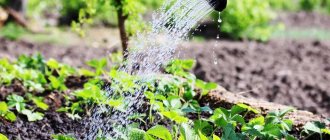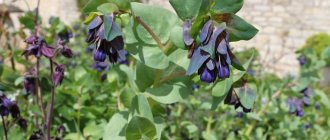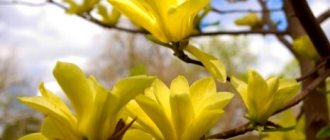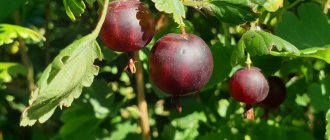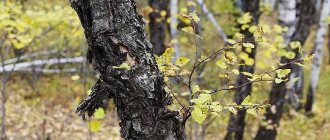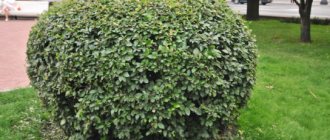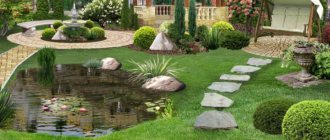Elm or elm is a deciduous tree whose height varies from 15 to 40 m depending on the species. A full-fledged adult tree has a round or elliptical crown, with spreading branches closely spaced to each other. The large foliage with asymmetrical pointed teeth at the edges has a rich green color and is located alternately on small cuttings. The flowering period lasts until the leaves bloom, and the fruits of this tree are lionfish. Young plants have smooth bark, while older plants have grooved bark with cracks. This tree lives quite a long time, so it is considered very practical for a permanent garden.
Split elm, lobed elm, split elm
Far East, Japan, China
deciduous montane forests
- up to 18 m;
- in Moscow at 35 years old - 9 m
wide-cylindrical, rounded at the top
from acidic to alkaline
rooting rate of cuttings – 20% when treated with Kornevin
at the beginning of fruiting, in autumn color
young branches are gray or yellowish
alternate, large, with apex elongated into a pointed point or with 3-5 (7) pointed lobes
Elm or Elm (Ulmus) in nature is a powerful tall tree or shrub. The genus of culture covers about 20 deciduous, rarely evergreen species, growing in temperate climate zones of North America, Europe and Asia.
In the garden landscape, only decorative elms are in demand, as they are easy to care for and have a long lifespan.
Large-fruited
Elm large-fruited lives in the East of Russia, Mongolia, China and the Korean Peninsula. It usually grows in river valleys, on wooded and rocky slopes. It is a shrub or small tree, the maximum height of which is 11 m
, with a large spreading crown. The bark is gray, brown or yellowish. The leaves are large, shiny, rough on top and smooth below.
The tree owes its name to its fruits, the large hairy lionfish that decorate it. A very heat-loving plant. This type of elm differs from its relatives in its extreme resistance to drought. Therefore, it is actively used to stabilize the soil of quarries, embankments and rocky slopes.
Elm tree, description
The leaves are serrated from 2 to 16 cm, depending on the species. They have a characteristic asymmetrical base and taper towards the top. The leaves are arranged alternately on the shoots, forming a thick, dense crown.
Red-violet flowers, collected in inflorescences of several pieces, appear along the shoots in March or early April. After pollination, small winged fruits are formed in place of the flowers, which are carried by the wind.
Elm seeds that fall into the ground germinate literally in a few days, and the tree begins to bear fruit at the age of 6-7 years.
Small
This species has many names - elm, birch bark, karaich, cork elm, red elm, field elm (tree in the photo). Distribution area: Ukraine, Russia, Asia Minor, Western Europe. It lives in deciduous and mixed forests, on river banks and high in the mountains.
The height of the tree ranges from 10 to 30 m. The crown is low. The leaves are oblong, obovate. Life expectancy is up to 400 years. Elm loves sunlit places and easily tolerates drought, but not frost. A distinctive feature is that the tree forms a wide network of surface roots.
.
This strengthens the topsoil and reduces the risk of erosion
. Therefore, field elm is often used not only for urban landscaping, but also for forest protection plantings. Cork growths are often found on branches, which increases the value of wood as a building material.
Garden varieties and types of elm with photos
Mountain elm or rough elm variety "Camperdownie" (Ulmus glabra Camperdownii ). It is a picturesque low tree with a characteristic weeping crown in the form of an umbrella of hard shoots.
The height of "Camperdownii" is usually 2 - 2.5 m. After a few years, the width of the crown can reach 6 - 18 m. The leaves are large, hard, and numerous. In autumn they acquire a golden yellow color.
Weeping elm "Pendula" with a compact crown. Another low-growing variety of mountain elm with shoots that form a green tent. Trees prefer sunny places and fertile soils.
The same type of variety from the Dutch (formerly "Monstros"). A rare dwarf elm, one of its smallest forms. Grows as a compact, round bush. At maturity, its size is only 40 cm in height and 40 cm in width.
The leaves are large, about 4 cm, which is special for this small plant. The unique appearance and shape of the variety fits perfectly into compositions of low-growing shrubs, coniferous crops and cereals.
Cork elm or elm (U. Minor) . Synonyms: small, field or hornbeam elm. In nature, it is a powerful, long-lived tree that grows throughout Europe. Three varieties have become widespread in horticulture.
"Argenteovariegata" . The decorative nature of elm lies in its variegated foliage with white and cream spots. It grows slowly. The height of an adult tree reaches 10 meters, and the width of the crown is 5 meters.
Typical requirements for this species are fertile, moderately moist soil, a sunny location, which enhances the brightness of the foliage color.
In the garden, “Argenteovariegata harmonizes well with other variegated plants, although such original varieties are usually planted separately to create a strong accent in the garden design.
"Webbiana" is an ornamental elm with a unique type of foliage. Throughout the season, the leaves of this tree are slightly curled. It seems that the tree is drying out or sick.
Meanwhile, this is a feature of the varietal form. Produces a wide crown of several large, strong branches. The maximum height is about 4-5 meters. It grows well in moist and fertile soil, but due to the structure of the foliage, which reduces water evaporation, the variety is resistant to prolonged drought.
The most popular and incredibly beautiful variety of this species is Jacqueline Hillier . Compact, low and slow growing tree. Its decoration is small, densely spaced, slightly curled, dark green leaves about 2-3 cm long.
Young leaves are pink. The varietal form is grown both on a standard and in the form of a bush. Can grow in any light. The variety is resistant to diseases and low temperatures, and can grow in fertile and poor soils. After 10 years, its height reaches 1.8 m.
White or American elm (Ulmus americana) . This tree is incredibly hardy; unlike many ornamental varieties and hybrids, it can withstand temperatures down to minus 42 °C! Unfortunately, this species is susceptible to Dutch disease.
Variety "Beebes-Weeping"
The tree has a high, slightly lacy crown. An interesting fact is that the American elm is not sensitive to photoperiod length - it will continue to grow throughout the fall, despite the shortening days, until its growth is stopped by frost.
Exotic for lovers
Magnolia
It can be formed as a bush, but a full-fledged tree with a picturesque crown can grow. Blooming magnolia is an exotic sight; most varieties have a delicate, vanilla-citrus aroma
. Magnolia is strewn with large flowers (bud length up to 12-15 cm). The color scheme and shape of the opened flower differs quite radically among different varieties of magnolia.
The whimsical nature of magnolia is greatly exaggerated; for successful cultivation it is enough to follow a few rules. When planting magnolia, special attention should be paid to the root system and the choice of planting site. You need to buy magnolia with a root ball (in a plastic container), preferably in a nursery or garden center. When planting, try not to injure the roots of the seedling. Magnolia loves bright sun and does not tolerate drafts and winds. The optimal planting location is under the southern wall of the house or any outbuilding. It does not like calcareous soils, so such lands must be acidified with peat. There is no need to care for an adult plant, only minimal sanitary pruning. For growing in gardens in the middle zone, deciduous forms of magnolia and corresponding hybrids are recommended.
Young seedlings, even frost-resistant varieties, should be covered for the winter (mulch the roots and cover the crown with agrofibre).
Sakura
The Japanese relative of the familiar cherry is famous throughout the world for its magical blooms. The growing conditions for sakura and magnolia are identical. Sunny place without drafts; neutral or slightly acidic soil
. Like ordinary cherries, sakura will require seasonal spraying against pests, abundant watering, and significant pruning.
It is not necessary to buy sakura; it reproduces well by cuttings
. This is much cheaper than buying a seedling. In August, the cuttings are grafted onto a traditional cherry (or sweet cherry) using the budding method (with an eye, a bud).
General rules for caring for elm
Species belonging to the genus Ulmus tend to be more demanding when it comes to substrate and moisture levels. Their natural habitats are predominantly wet and fertile areas near rivers. However, the soil must be permeable, since elm does not tolerate stagnant water.
Young elm seedlings after planting require regular watering; the soil should not dry out. Mature trees are watered in the absence of rain and after a snowless winter.
Poor soils are enriched with compost or humus. The ground around the plantings is mulched with a thick layer of compost, bark or pebbles, which avoids moisture evaporation.
Elm care includes sanitary pruning, which is carried out in early spring. Since the shoots grow very slowly, severe shortening is not recommended.
Pests and diseases of elm
Elms were once one of the most popular trees in the European landscape. Unfortunately, in the twentieth century, many of them were affected by Dutch elm disease (DED).
The first symptoms of the disease are observed already at the turn of May and June, when at high temperatures the leaves begin to curl, fall off, and the stems dry out. This disease is quite aggressive, therefore preventive or therapeutic (at the onset of the disease) treatment with Topsin M 500 SC is necessary immediately after the temperature rises above 15 °C.
How to get rid of aphids using folk remedies - read here
The treatment is repeated after 10-14 days, trying to spray the preparation on all parts of the tree. The next treatment is repeated in the summer, and the last one is carried out in the fall. The Dutch hybrid is most susceptible to the disease; other ornamental elms are more resistant.
Plantings can also be affected by viral and fungal diseases. For this reason, observation from the beginning of the growing season and preventive treatment are required.
The most famous pest is the elm leaf beetle, the aphid. In autumn (October, November) preventive spraying can be carried out. For this purpose, insecticides Promanal or Treol based on paraffin oil are used. Leaves are burned in the fall to prevent the spread of disease and pests.
Trees of the genus elms (or, as they are less commonly called, elms) belong to the deciduous Elm family. They grow in abundance in Western Europe, the Volga region, the southern part of European Russia, the southern Urals, Central Asia, and the Caucasus.
It has been established that elms separated into an independent genus, consisting of several dozen species, approximately 40 million years ago. Some species are more often called elm, birch bark, and in the areas of distribution of Turkic languages, small-leaved and squat elms are called “elm”. The most common type is the common or smooth elm.
Elm is reflected in the cultures of various ethnic groups. Our ancestors believed that the branches of this tree bring good luck and endow the traveler with strength and courage. In Christianity, it symbolizes human dignity. For many other peoples, the elm was a symbol of motherhood, birth and new life. In Britain, an elm branch along with a grapevine is a symbol of lovers.
Reproduction
In nature, elm propagation occurs by self-seeding. The seeds quickly lose their viability, so when growing elm seeds, only freshly harvested material is sown (May-June). Before planting, they are moistened for 2-3 days and treated with a fungicide. Planting depth 1 cm, distance between holes 20 cm, cover with moss or hay on top, water well. Shoots appear in a week. After the sprouts have become stronger, the moss is removed and the soil around is well loosened. Watering is reduced and stopped by mid-August. From seeds in the first year, plants grow up to 15 cm, then annually they grow up to 40 cm. It is better to wrap small plants for the winter.
Elms also reproduce vegetatively: by stump shoots and root suckers. The reliability of such methods is low, so it is better to purchase a ready-made 3-4 year old seedling.
Elm seeds
Popular types
The following types of elm tree are described.
Hornbeam
Hornleaf elm is found in Central Asia, the Caucasus, Europe and North Africa. This is a light-loving deciduous tree, but it also grows in the shade without any problems. It reaches a height of twenty-five meters, the maximum diameter of its crown is ten meters.
Elms are characterized by a high growth rate and tolerate pruning well, making these trees well suited for forming hedges. They will look great on a well-kept lawn. In appearance they go well with bird cherry, rowan, as well as apple and cherry trees.
The biological description of this species is as follows. Corky growths sometimes appear on dark brown branches. The pointed leaves are large in size , smooth on top, and their underside is covered with delicate hair. The foliage, dark green in summer, changes its color to bright yellow in autumn. Even before the leaves appear, small flowers bloom, collected in bunches.
They are unpretentious and can withstand frost and drought very well. When grown in favorable climatic conditions, their age can be up to three hundred years. Hornbeam elm is used medicinally. It is used to prepare diuretics and antiseptics. Its bark has the ability to slow down the absorption of cholesterol. A decoction of elm bark is also used to treat burns and some skin diseases.
Hornleaf elm prefers rich, moist soil. For active, high-speed growth, it requires periodic watering and fertilization, for example, adding lime to the soil, which has a beneficial effect on the tree.
Recommendations for growing:
- Nutritious, moist soil is better suited;
- if natural moisture is insufficient, trees require watering;
- Periodically, elms should be fertilized with lime.
Smooth
Smooth elm is also sometimes called common and large-leaved elm. Distributed throughout Europe. It grows up to twenty, and in rare cases up to forty meters in height. It has a wide crown with a diameter of up to twenty meters. The trunk of such an elm is straight, with a diameter of up to one and a half meters. The bark covering young shoots is smooth, but with age it becomes rougher, cracks and begins to flake off. Large leaves have a pointed or ovoid shape. The upper side of the leaf is dark green, the lower side has a lighter shade. In autumn the foliage changes color to brownish purple. Small brown flowers bloom in spring .
These plants are characterized by a developed root system. In mature trees, thick roots can protrude from the trunk to a height of up to half a meter above the ground. The tree grows quickly, and its lifespan can sometimes be four hundred years. Tolerates drought well, but prefers moist soil. It tolerates short-term flooding without any difficulties.
The common elm tree has dense , durable wood, but is quite easy to process. This tree is widely used in the production of furniture and other carpentry. Elm does not rot in water, so in the Middle Ages water pipes and supports for piers and bridges were made from it. Smooth elm bark was used in tanning leather.
Elm is also of great benefit in urban areas - its leaves can retain a much larger amount of dust than other trees. Thanks to their extensive root system, elms are well suited for strengthening the soil on the sides of ravines and on cliffs.
Androsova
Androsova elm is an artificially obtained hybrid of squat and dense elms. A mature tree can reach twenty meters in height. It has a dense spherical crown, thanks to which it provides good shade. Covered with gray bark. The leaves, like those of many elms, according to the description, have an ovoid or pointed shape.
It often grows in moist soils, but can easily tolerate drought . It forms many side shoots , making it excellent at capturing dust in urban environments. The crown of this tree lends itself well to shaping, which allowed the elm to become one of the most popular garden plants.
-loving perennial ornamental plants grow well under the canopy of elm crowns
- Wolfsbane (Wrestler);
- Bell;
- Buzulnik Przhevalsky;
- catchment;
- Saxifraga;
- Asparagus;
- Ferns;
- Astilbe.
Thick
Dense elm is rare in nature, mainly in Central Asia. This large tree can reach a height of up to thirty meters. Its developed crown has a pyramidal shape and provides excellent dense shade. Young branches are covered with light brown or grayish bark, which darkens over time. The leaves are medium-sized, no more than seven centimeters in length, with a characteristic ovoid shape.
This elm is unpretentious, frost- and drought-resistant, but grows better in moist soils. The hardy tree tolerates gas pollution well.
Bladed
Lobed elm is also called cutting or mountain elm. Found in the Far East, including Japan and China. This is a characteristic tree species for deciduous and mixed forests. It can be found in mountain forests at altitudes up to two kilometers. Usually it grows no higher than thirty meters.
Decorative forms of fruit trees
The familiar apple tree has many decorative subspecies that bloom more abundantly than ordinary apple trees. Blooming with scarlet flowers, the Ola apple tree is simply filled with flowers so that the branches are not visible
.
Apple tree color Ola
Ornamental varieties are grown using familiar agricultural techniques familiar to gardeners for caring for traditional apple trees. Fruits - small (paradise) apples decorate the garden until late autumn
. Yellow, red, purple - look great on branches. They attract birds to the garden, a modern option for a natural solution to pest problems. Apples of paradise make original jam. Especially interesting are the weeping forms, with variegated and colored leaves.
Areas where elm is used
Due to its outstanding qualities, elm is used in many sectors of the economy.
- Elm wood is characterized by high strength, resistance to high humidity, but at the same time it is easy to process and has a beautiful texture. It is often used in furniture making, shipbuilding and household utensils.
- Young tender shoots and seeds are used as livestock feed.
- The bark serves as a raw material for making paints.
- Widely used in medicine in the fight against diseases of the genitourinary system and gastrointestinal tract, the bark is used in the treatment of skin diseases.
- Elm plays an important role in beekeeping as a good honey plant.
- Elm is ideal for landscaping city streets due to its appearance and high adaptability.
| Ulmus lacinata Family |
How to plant and care?
In a word, elm on a personal plot is good and healthy. How to plant it? First, let's please gardeners who every year fight with young shoots of apple and cherry trees. Elm does not reproduce through its root system. The main method of planting it is cuttings. You can propagate elms on your property yourself - you can root dozens of cuttings from one mature tree and, if you wish, create a real street of elms in your dacha without any nightmares. The best time for rooting is June and July.
There are no special tricks in planting this tree, but for the first three to four days the tree needs plenty of watering (up to ten liters of water per square meter), especially if the weather is hot outside. After planting, the tree trunk space is mulched with peat or wood chips in a layer of up to ten centimeters.
The active growth period for elms occurs in the middle zone from April to October. All work on pruning and thinning the crown must be carried out before the growing season. The exception is the work on topiary molding, which is carried out throughout the summer.
But it’s better not to rush with molding. In the first years you will only need to remove dried and dead branches, and begin the first serious pruning around the fourth year. The main thing is not to forget to generously coat all cut areas with thick garden varnish so that fungi or bacteria do not get into the wounds. In general, elm gets sick very rarely, and pests do not like it, but sometimes weakened trees can become victims of spider mites.
And lastly, if you contact elm, then it will last for a long time. The tree is distinguished by its love of life. There are individual plants of this species known in the world whose age reaches 500 and even 800 years. Even in indoor conditions, elm can live more than 50 years.
Dear readers, we bring to your attention a video about squat elm
:
" Trees
Gardens and dachas of the new wave - stylish cottages, with a comfortable area for residents to relax, surrounded by a beautiful landscape. A traditional dacha, the main function of which is harvesting, also necessarily includes a recreation area
, lovingly decorated by the owners. It is for the spectacular design of a backyard area, a beautiful lawn, a children's playground, that ornamental plants and trees are needed, which are worth talking about in detail.
In addition to the natural aesthetic function of giving a person enjoyment of the beauty of nature, ornamental trees and shrubs are used by gardeners and designers to solve purely practical problems. Visual expansion of a too narrow or very small area. Decorating outbuildings, strengthening sloping areas and screes. Zoning the site, creating dividing screens between the vegetable garden and the garden area. Protecting the individual space of a small dacha from prying eyes, without erecting a fence.
What affects lifespan?
The main factor influencing the lifespan of a tree is its type. Thus, fruit trees live the shortest - their lifespan is calculated in decades. But deciduous and coniferous trees can live for hundreds and even thousands of years - they are the basis of the “evergreen” forests of our planet.
Coniferous trees
Coniferous trees have a longer lifespan than their deciduous counterparts. Reasons for longevity:
- Representatives of coniferous species tolerate harsh climates more easily.
- Unpretentious regarding soil. They can grow on poor sandstones and clayey soils.
- Thanks to their branched root system, coniferous trees are hardy and absorb water from the soil well.
- Thanks to the special shape of the crown, they receive maximum solar energy even at high growth densities.
- The needles, unlike the leaves, have a small surface area and are covered with wax - this helps retain moisture in it.
The lifespan of coniferous trees can be influenced by the following factors:
- Genetics. Each plant has certain adaptation capabilities.
- Soil characteristics have a much smaller impact than on the growth of deciduous trees.
- Humidity and temperature have little effect - coniferous trees grow in their familiar environment. Their lifespan can only be affected by global climate change.
- Terrain – plain, slopes, mountains. The strength and direction of the wind depends on it.
- Forest density - coniferous trees are minimally affected, since their crowns are adapted to difficult conditions.
- Diseases and pests . Fungal and bacterial infections can significantly reduce the lifespan of any tree.
Deciduous trees
The lifespan of deciduous trees can vary greatly, even within the same species. The following factors may influence lifespan:
- Soil characteristics - its density, composition, saturation with nutrients and microelements.
- Climatic conditions - humidity, average annual temperature, wind strength and direction, other indicators.
- Surroundings – how close neighboring trees grow. If the growth density is high, then only the strongest individuals live long.
- Insects and other pests.
- Location – natural environment or urban conditions. It is clear that in a city where the air is polluted, trees live less.
Fruit trees
The lifespan of fruit trees is affected by:
- Type of fruit tree.
- Soil quality and fertilizing.
- Pruning, treatment, winterization and other care activities.
- Destruction of pests, especially bark beetles, which can destroy a tree in a couple of years.
Why, despite increased care, do fruit trees live so short? Large harvests are expected from fruit trees. By artificially accelerating the growth of a tree, a person forces the tree to waste its resources - it, having used up its reserve of strength, weakens ahead of time and dies.
Medicinal properties
The medicinal properties of elm are little known, but people who have tried to be treated with decoctions and infusions from the bark and leaves of the tree always keep prepared dry elm raw materials at home. The chemical composition of elm leaves and bark is varied : it contains ascorbic acid, tannins, steroids, flavonoids, and phenolcarboxylic acids.
Elm infusions and decoctions reduce inflammation, have an antibacterial effect, and accelerate wound healing. Plant extracts are used to treat diseases of the kidneys, skin, musculoskeletal system, heart and blood vessels, and thyroid gland. A decoction of elm bark is used to gargle for sore throats, and tea from the leaves is drunk for constipation. For hemorrhoids and kidney diseases, baths with the addition of bark decoction are useful. The infusion is used as a lotion for skin rashes and difficult-to-heal wounds.
When treating with infusions and decoctions of elm bark and leaves, it must be taken into account that plant materials can cause hypersensitivity reactions, which manifest themselves in the form of allergies. You also need to understand that not all diseases can be cured with traditional methods; if symptoms worsen, you should definitely see a doctor.
Elm forests
In nature, pure elm forests are extremely rare. Their massive plantings are observed in coniferous-deciduous and broad-leaved forests in Asia, Europe, Scandinavia, North America, and the Balkans. And if in Europe the smooth, rough, elliptical, leaf elm is more common, then in Asia it is the squat, valley, lobed elm, and in America it is the American elm.
In Russia, deciduous elm trees grow in the Far East, the Southern Urals, the southeastern part of the Russian Plain and the Central region. The most common forests contain the following types of elms: leaf, lobed, small-leaved, smooth, cork, mountain (rough), large-fruited and Japanese. Preferring fertile soils, they grow mainly along the shores of lakes and in floodplains. The total area of such plantings occupies 500 thousand hectares.
Interesting Facts
- The famous London Bridge owes its stability to the elm wood that was used in its construction.
- In Korea, there is an elm tree whose age has exceeded 800 years. It is very small in height, only 7 meters, but in diameter it reaches almost 2 meters.
- In ancient times, the elm was used to support a vineyard, causing the Greeks to associate it with the god of wine, Dionysus.
- Elm fruits are widely used in Chinese cuisine and are a common ingredient in salads.
- The aroma of elm wood acts on humans as an antidepressant and gives a calming effect.
- Until recently, on Povarskaya Street in Moscow, a long-living elm, which witnessed the fires of 1812, was “whileing out” its old age. But the tree could not withstand the abnormal heat of 2010 and withered.
- Many buildings of the beautiful Venice, the famous city on the water, stand on stilts made of elm.
- The Slavic name for the elm tree comes from the verb “to knit,” since the tree’s twigs were successfully used in the process of knitting sleighs, baskets and other household utensils.
- In England, the elm and the vine symbolize faithful lovers.
Brief information
Elm is a genus of trees in the Elm family. It also has other names: elm, birch bark, ilmovik or elm. There are more than 40 species of elms, most of them are found in the subzone of deciduous forests; closer to the south they can grow in spruce and coniferous forests.
They rarely grow alone; they prefer the vicinity of other trees; elm forests are also rare. On average they live 80-120 years, occasionally living up to 300-400 years. In the first few years they actively grow and develop; after 40-60 years, growth slows down and comes to naught.
Elms can reach 40 meters in height and 2 meters in diameter, and some species can grow as a bush.
The root system does not have a central root: some roots penetrate deep into the soil, the rest are located closer to the surface. On podzolic soils, the roots are close to the surface.
It is important to know:
Many species of elm are on the verge of extinction due to diseases and attacks by pests: leaf beetles, springtails, and fungi.
The leaves are 20 cm in size, have sharp, jagged edges, and are symmetrical. All leaves differ in shape and size, even if they originate from the same shoot - this is easy to see in photos or pictures.
Together they form a very dense crown through which the sun does not pass. Leaf growth begins only after fruit formation, and in the fall the elm is one of the first to lose its leaves.
The flowers are quite small and inconspicuous, growing and developing before the leaves appear. Occasionally, flowering may begin in the fall. The fruits ripen already in April-June (the further south the region, the faster). They are nuts with wings that are carried by the wind throughout the surrounding area.
When placed in moist soil, they begin to grow within a few days. Southern species bear fruit from 5-10 years, northern ones - after 20 years. In addition to seeds, they can reproduce by roots and shoots that appear on stumps.
The economic importance of the plant is quite high:
- The wood of the tree is extremely durable, resistant to dampness and does not splinter easily, but at the same time easily tolerates processing and has high aesthetic qualities. It is often used in furniture making, and was previously used to build ships, weapons and dishes.
- Young shoots and seeds are used to feed livestock.
- Paints are obtained from the bark.
- In medicine, elm is used to combat diseases of the genitourinary system and digestion, and the bark is used for skin diseases.
- Elm is an excellent honey plant loved by bees.
- Elm is often used for urban landscaping, since the crown does not require trimming and does an excellent job of purifying the air.
The plant easily tolerates many unfavorable conditions (drought, rain, severe frost), which makes it an extremely popular and sought-after tree in difficult urban environments. In the wild it chooses deciduous and coniferous forests, and is artificially grown within the city.

